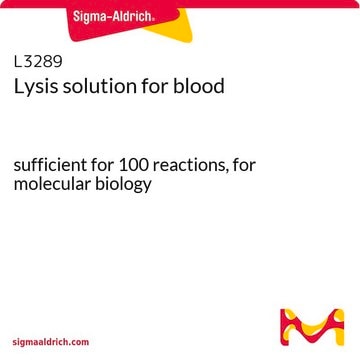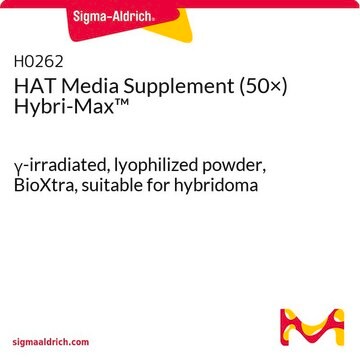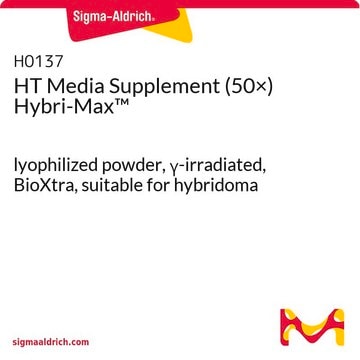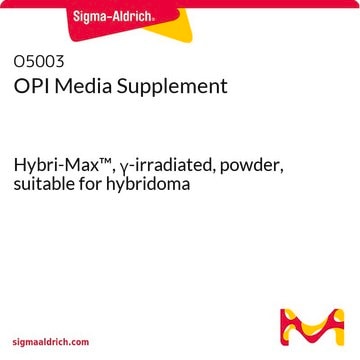R7757
Red Blood Cell Lysing Buffer Hybri-Max™
Liquid, sterile-filtered, suitable for hybridoma
Sinónimos:
RBC Lysing Buffer
Iniciar sesiónpara Ver la Fijación de precios por contrato y de la organización
About This Item
UNSPSC Code:
12352207
NACRES:
NA.75
Productos recomendados
product name
Red Blood Cell Lysing Buffer Hybri-Max™, liquid, sterile-filtered, suitable for hybridoma
sterility
sterile-filtered
form
liquid
technique(s)
cell culture | hybridoma: suitable
impurities
endotoxin, tested
Application
Recommended for use by adding 1 mL of buffer to a cell pellet (cell pellet = 1 spleen or 100-200 million cells). Gently mix for 1 minute. Dilute the buffer with 15-20 mL of medium or salt solution. Centrifuge at 250-500 × g for 7 minutes and decant the supernatant. Cells may be diluted and prepared for counting or fusion. If lysis is incomplete, steps 1-4 may be repeated.
Biochem/physiol Actions
Red Blood Cell Lysing Buffer has been developed for use in hybridoma protocols to remove red blood cells from mouse splenocyte suspensions before fusion. It is also useful in systems where it may be desirable to remove red blood cells from cell suspensions, such as whole blood.
Components
Contains 8.3 g/L ammonium chloride in 0.01 M Tris-HCl buffer.
Other Notes
Note: This product is intended for the removal of red blood cells from mice. This product may not be appropriate for the lysis of red blood cells of other animals. The suitability of the product in any application other than mouse splenocytes must be determined by the researcher.
Legal Information
Hybri-Max is a trademark of Sigma-Aldrich Co. LLC
Storage Class
12 - Non Combustible Liquids
wgk_germany
nwg
flash_point_f
Not applicable
flash_point_c
Not applicable
Certificados de análisis (COA)
Busque Certificados de análisis (COA) introduciendo el número de lote del producto. Los números de lote se encuentran en la etiqueta del producto después de las palabras «Lot» o «Batch»
¿Ya tiene este producto?
Encuentre la documentación para los productos que ha comprado recientemente en la Biblioteca de documentos.
Los clientes también vieron
John M Furgason et al.
Mutagenesis, 29(5), 341-350 (2014-08-12)
Next generation sequencing has become a powerful tool in dissecting and identifying mutations and genomic structural variants that accompany tumourigenesis. Sequence analysis of glioblastoma multiforme (GBM) illustrates the ability to rapidly identify mutations that may affect phenotype. Approximately 50% of
H Guan et al.
Oncogenesis, 4, e166-e166 (2015-09-08)
Recent advances have highlighted profound roles of FOXO transcription factors, especially FOXO1, in bone development and remodeling. The regulation of bone development by FOXOs seems to be stage-specific or context dependent. FOXOs promote maintenance and differentiation of early progenitors of
Iris Boraschi-Diaz et al.
Cytotechnology, 68(1), 105-114 (2014-09-24)
Osteoclasts are responsible for physiological bone remodeling as well as pathological bone destruction in osteoporosis, periodontitis and rheumatoid arthritis, and thus represent a pharmacological target for drug development. We aimed to characterize and compare the cytokine-induced osteoclastogenesis of bone marrow
Christopher J M Piper et al.
Cell reports, 29(7), 1878-1892 (2019-11-14)
Regulatory B cells (Bregs) play a critical role in the control of autoimmunity and inflammation. IL-10 production is the hallmark for the identification of Bregs. However, the molecular determinants that regulate the transcription of IL-10 and control the Breg developmental
Guoxi Yang et al.
Journal of cellular and molecular medicine, 21(12), 3445-3452 (2017-07-01)
Macrophage surface antigen-1 (Mac-1, CD11b/CD18) has been implicated in the regulation of osteoclastogenesis. In the synovial tissues of patients with aseptic loosening after total hip replacement, CD11b was up-regulated, which indicated that CD11b is closely involved in osteolysis around the
Nuestro equipo de científicos tiene experiencia en todas las áreas de investigación: Ciencias de la vida, Ciencia de los materiales, Síntesis química, Cromatografía, Analítica y muchas otras.
Póngase en contacto con el Servicio técnico












